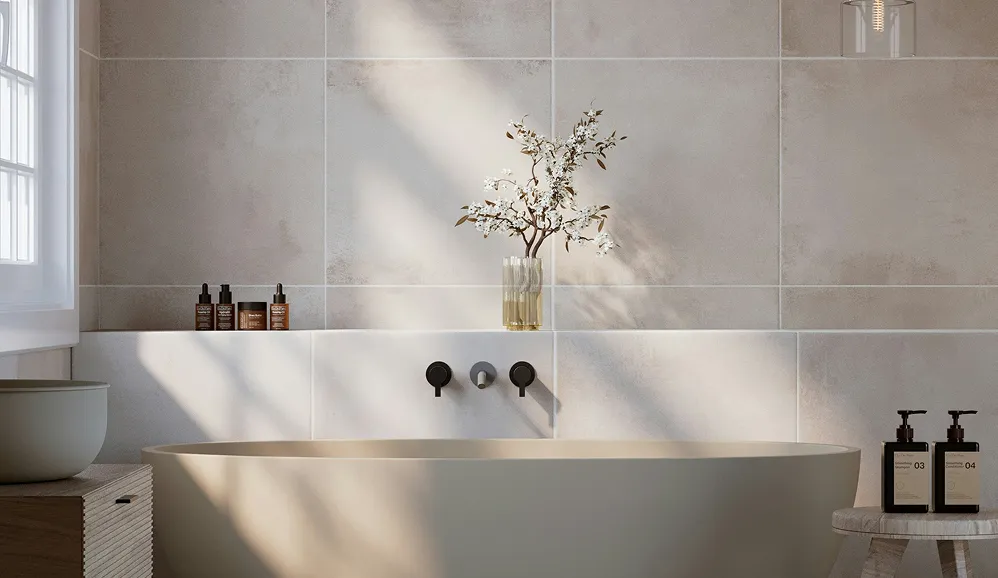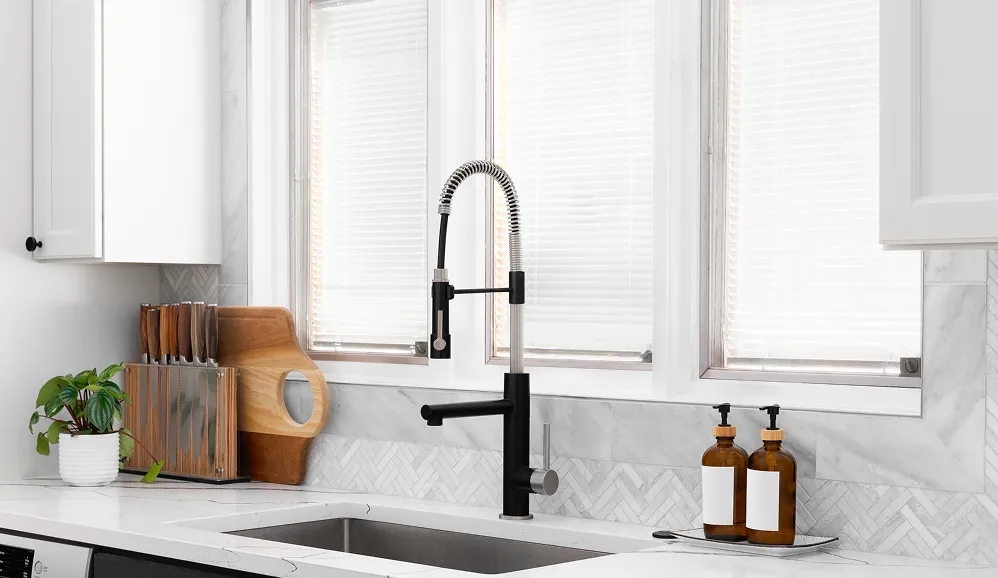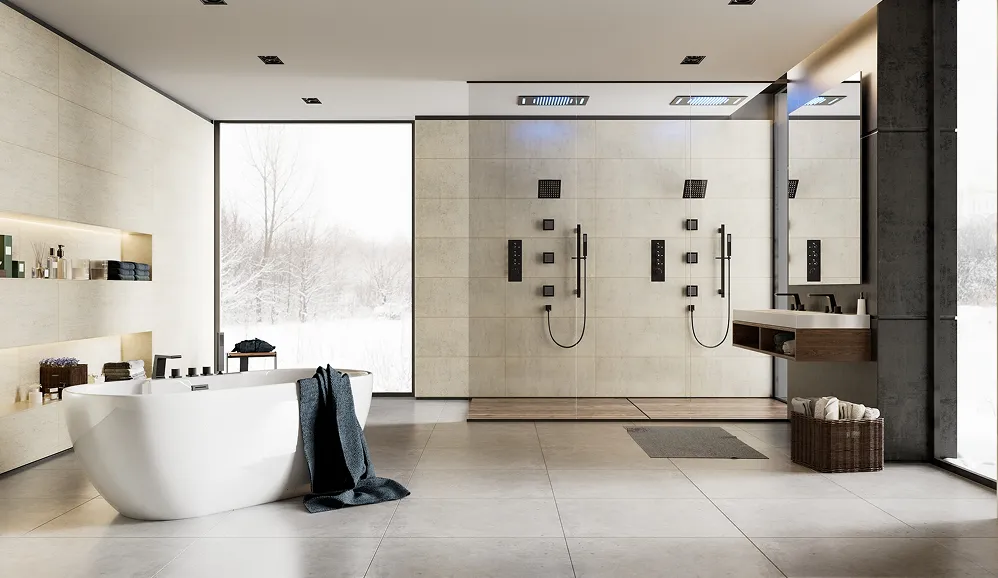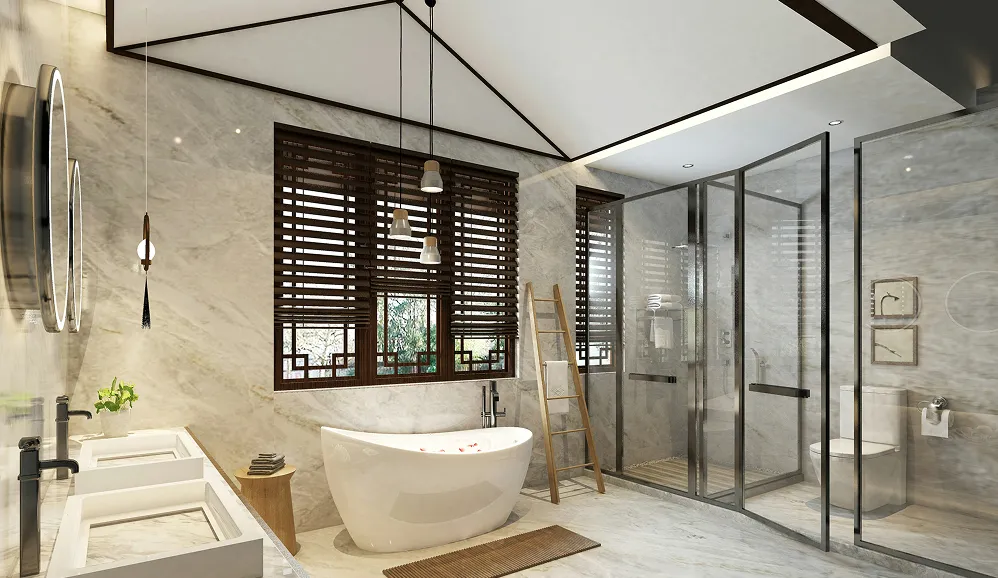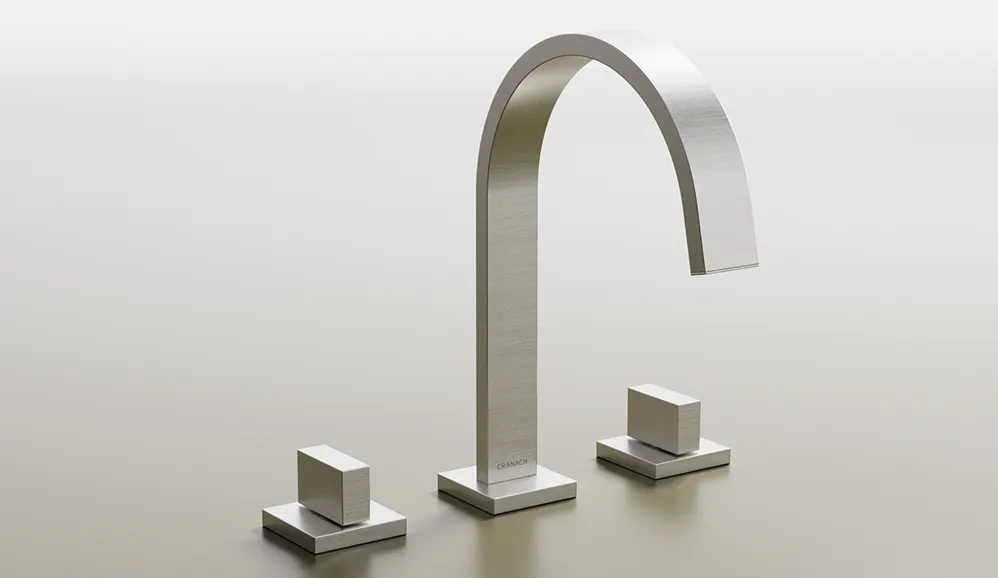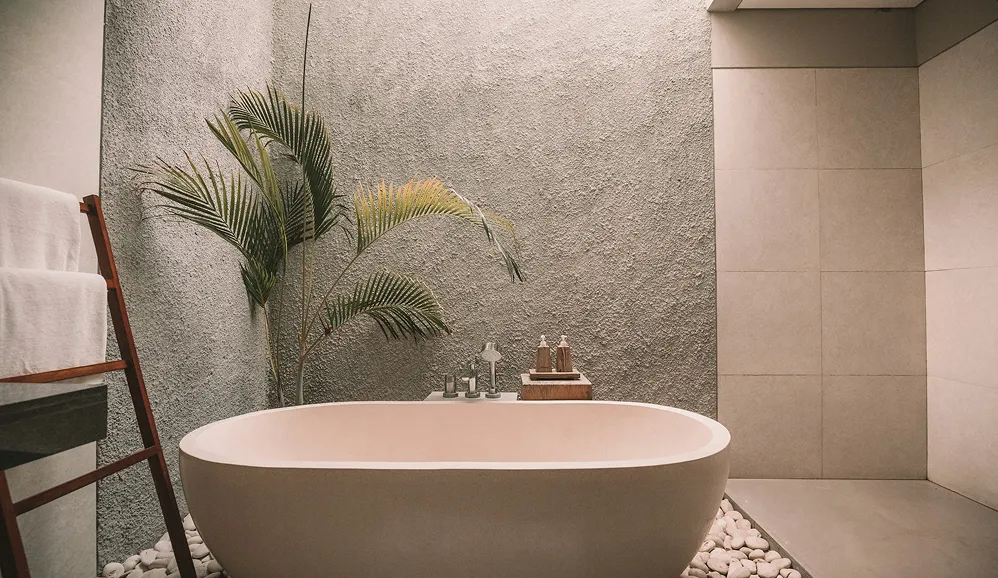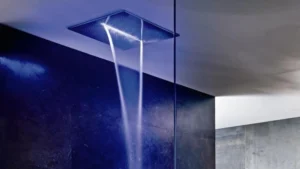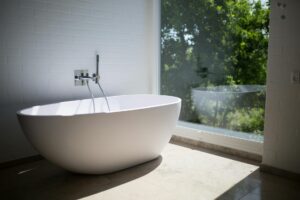A weak shower can be a frustrating start to the day. Before you start unscrewing pipes or shopping for new fixtures, the first thing to do is play detective. Let’s figure out if the problem is just your shower or if it’s a house-wide issue.
Getting to the root of the problem now will save you a ton of time and effort down the line.
Diagnosing Your Weak Shower Pressure Problem
First things first, turn on the faucet in your bathroom sink, and walk over to another faucet. If every fixture in your home is delivering a disappointing trickle, the issue likely lies with your main water supply or a pressure-reducing valve for the whole house.
Key Insight: Pinpointing whether the low pressure is isolated to one fixture or is a whole-house problem is the most critical first step. It tells you whether you’re dealing with a simple fix like a clogged showerhead or a more complex plumbing issue.
Before we dive into solutions, let’s use a quick checklist to narrow down the possibilities. This can help you immediately focus your efforts on the most likely culprit.
Quick Diagnostic Checklist for Low Shower Pressure
| Symptom | Possible Cause | First Action to Take |
|---|---|---|
| Only the shower has low pressure; it got worse over time. | Mineral Buildup in the showerhead. | Deep clean the showerhead nozzles. |
| Only the shower has low pressure; it happened suddenly. | A clogged filter screen in the showerhead. | Remove and clean the filter screen. |
| All faucets in the house have equally low pressure. | Issue with the main water line or pressure-reducing valve. | Check your home’s main shut-off valve and pressure regulator. |
| The shower pressure is weak but steady; it’s a newer fixture. | The flow restrictor is limiting the water too much. | Consider removing the flow restrictor. |
This simple diagnostic process helps you avoid chasing the wrong problem. If your issue is confined to the shower, let’s move on to the most common causes.
Is It the Showerhead or Something More?
When it’s just the shower, the problem usually stems from one of three common roadblocks right there at the fixture. I see these all the time.
- Mineral Buildup: If you have hard water, it leaves behind calcium and magnesium deposits (limescale) that clog up the tiny nozzles on your showerhead. This is, by far, the most frequent cause of a shower that’s lost its power over time.
- Clogged Filter Screen: Almost every showerhead has a small mesh screen where it connects to the shower arm. Its job is to catch sediment and debris from the water lines, but eventually, it can get completely blocked.
- Flow Restrictor: To meet water conservation standards, most modern showerheads come with a small plastic disc inside called a flow restrictor. While it’s there for a good reason, sometimes it limits the pressure more than you’d like.
This image really helps visualize how pressure is managed from the street all the way to your shower.
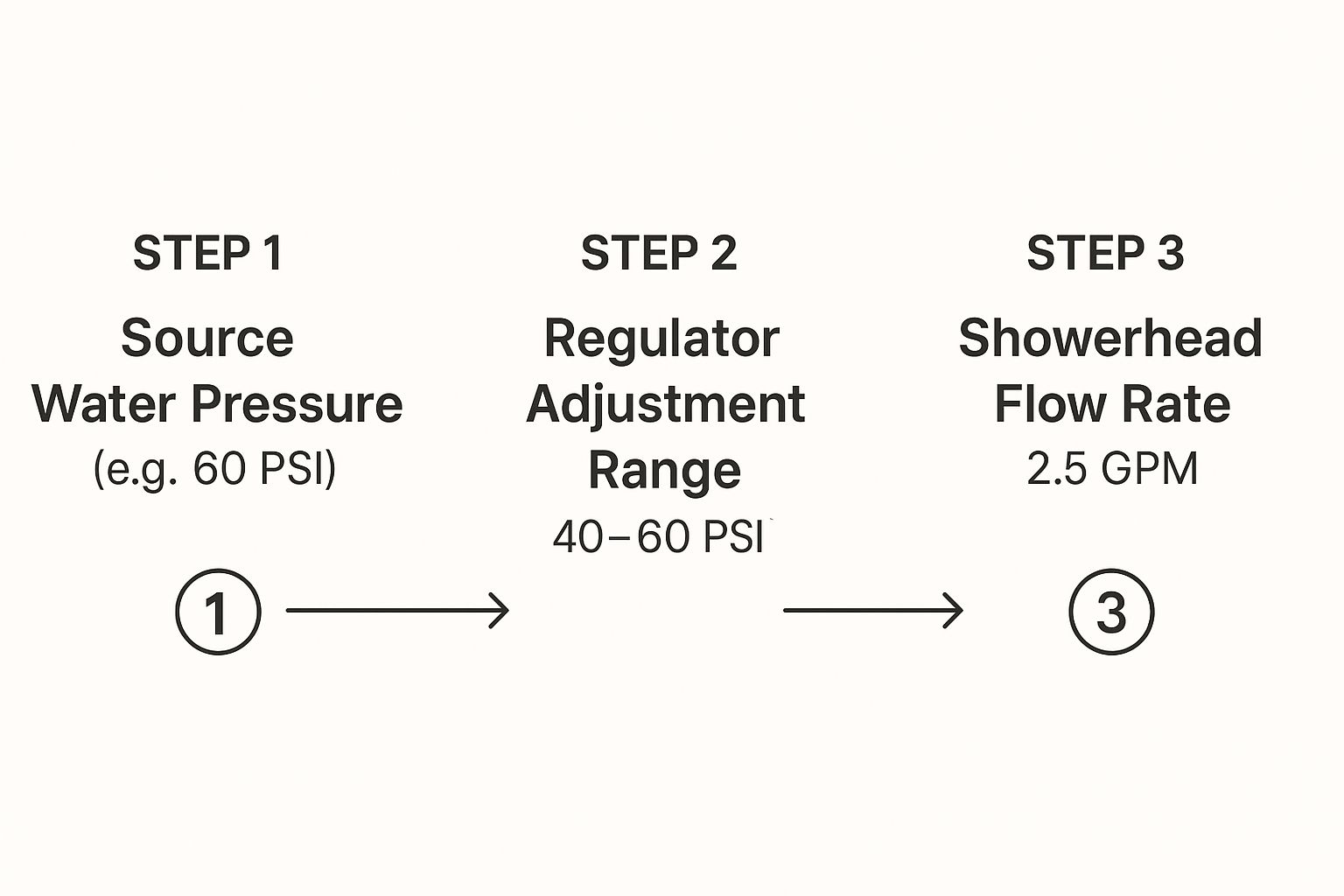
Deep Cleaning Your Showerhead for Better Flow
If your shower has slowly lost its oomph, the most likely culprit is hiding in plain sight. Over time, mineral deposits—think limescale and calcium from hard water—build up inside your showerhead. This accumulation effectively chokes the water flow, turning what should be a powerful spray into a disappointing dribble.
The great news is that you often don’t need a whole new fixture to fix this. A thorough cleaning is one of the most effective ways how to increase the water pressure in your shower. By dissolving these mineral clogs, you can get your showerhead performing like it was brand new.
The Vinegar Soak: A Simple and Effective Method
You don’t need any harsh, specialized chemicals for a deep clean. Plain white vinegar is your best friend here. Its natural acidity is perfect for breaking down stubborn mineral buildup without damaging your fixture’s finish. Depending on whether your showerhead is removable, you have a couple of ways to tackle this.
If your showerhead is fixed to the wall and tough to get off, you can easily clean it right where it is.
- First, grab a sturdy plastic bag (a freezer bag works great) and fill it with enough white vinegar to completely cover the face of the showerhead.
- Next, carefully slip the bag over the showerhead, making sure all the nozzles are fully immersed in the vinegar.
- Use a rubber band or zip tie to secure the bag tightly around the shower arm, holding it in place.
- Let it soak for at least a few hours. For really heavy buildup, leaving it overnight is your best bet.
For a more comprehensive clean, it’s ideal to remove the showerhead. This usually just takes an adjustable wrench and a rag to protect the finish from scratches. Once it’s off, you can submerge the entire head in a bowl of vinegar. After it’s done soaking, grab an old toothbrush and gently scrub away any leftover gunk from the nozzles. You can find more details in our complete guide to cleaning your shower head with vinegar.
Pro Tip: Before you screw the showerhead back on, turn the water on for just a few seconds. This will flush out any loose debris that might be lingering inside the shower arm.
Don’t Forget the Filter Screen
This is a crucial step that so many people miss. Tucked inside the neck of the showerhead, right where it connects to the pipe, is a small mesh screen. This filter’s job is to catch sediment and debris before it can get into the nozzles and clog them. Naturally, this screen can get completely blocked itself over time.
You can usually pull it out carefully with a pair of needle-nose pliers. Give it a good rinse under the sink and use a small brush to scrub away any stubborn buildup. Putting a clean filter screen back in can make a massive difference in your water flow.
Checking and Adjusting Your Home Water Valves
If you’ve deep-cleaned your showerhead and the water pressure still feels weak, the problem might not be the fixture at all. The real bottleneck could be lurking further down the line at one of your home’s main water valves. These valves are the gatekeepers for your entire home’s water supply, and if they aren’t fully open, every faucet and fixture will suffer.
Locating Your Main Water Valves
First things first, you need to find your home’s main water shutoff valve. This is the point where the municipal water line enters your house.
You’ll typically find it in a few common spots:
- In the basement, usually near the front foundation wall.
- Tucked away in a garage or utility closet.
- In a crawl space, often near the front of the house.
- Sometimes it’s even outside, near the water meter itself.
You’re looking for one of two valve types. A gate valve has a round, spigot-like handle that you turn multiple times. A ball valve has a straight lever handle; when the lever is parallel with the pipe, it’s open, and when it’s perpendicular, it’s closed. Whichever type you have, make sure it’s turned all the way to the fully “open” position.
Don’t forget to check the shutoff valve on your water heater, which only impacts your hot water supply. If your cold water pressure seems fine but the hot water is just a trickle, this is your prime suspect. Look for a valve on the cold water inlet pipe that leads into the heater tank and, just like the main shutoff, ensure it’s completely open.
Keep in mind, if you’re spotting mineral deposits on these valves, there’s a good chance they’ve built up inside your faucets, too. For more on that, check out our guide on removing calcium deposits from faucets.
When to Upgrade Your Showerhead for More Power
An old or poorly designed fixture can be the ultimate bottleneck in your system. It doesn’t matter how much water pressure your home has if the fixture at the end of the line can’t deliver a satisfying spray. This is where an upgrade can make a world of difference.
Modern showerheads are genuine marvels of engineering, designed specifically to tackle this common frustration. They don’t just let water pass through; they actively shape and accelerate it to completely transform the experience.
How Modern Showerheads Maximize Pressure
The secret behind a great high-pressure showerhead isn’t about using more water. In fact, many of the best ones are actually water-saving models that just feel more powerful. The magic is all in their internal design.
- Pressurization Chambers: Many fixtures have an internal chamber where water builds up for a moment before being forced out. This creates a brief but significant boost in pressure right where it counts—at the nozzles.
- Optimized Nozzle Design: Instead of wide, lazy streams, the nozzles are smaller and strategically angled. This simple constriction increases the water’s velocity, making it feel much stronger against your skin.
- Aeration Technology: Some models work by infusing the water with tiny air bubbles. This bulks up the individual water droplets, making them feel fuller and more substantial without actually increasing the flow rate.
What to Look for When Choosing a New Fixture
When you’re ready to upgrade, just grabbing the first box that says “high-pressure” might not get you the results you want. Knowing what to look for is key to making an investment that pays off every morning. The first thing to check is the Gallons Per Minute (GPM) rating.
Federal standards limit showerheads to a maximum of 2.5 GPM, but many of the best high-pressure models operate at just 1.8 or 2.0 GPM. A lower GPM doesn’t mean weaker pressure; it means the fixture is more efficient at creating a powerful, invigorating spray with less water.
A new showerhead with a 1.8 GPM rating can often feel much stronger than an older, inefficient 2.5 GPM model, all while saving you money on your water and heating bills.
Build quality is the other huge factor. Look for fixtures made from durable materials like solid brass or stainless steel. Not only do they last longer, but they’re also better at resisting the mineral buildup that causes clogs in the first place. For a deeper dive, our complete guide explores many other ways https://cranachhome.com/articles-howtosolutions/how-to-increase-shower-water-pressure/.
Ultimately, choosing the right showerhead is one of the most direct and satisfying ways to fix a weak spray for good. It tackles the problem at the final point of delivery, ensuring you get the absolute most out of your home’s available water pressure.
Advanced Solutions for Persistent Low Pressure
So, you’ve done everything by the book. You’ve soaked the showerhead, checked all the valves, and maybe even upgraded to a brand-new fixture. If you’re still dealing with a disappointing drizzle, the problem is likely running deeper than what simple fixes can handle. It’s time to look at the bigger picture—the plumbing that’s throttling your water pressure at the source.
When the usual troubleshooting steps don’t work, you have to start thinking about the arteries of your home’s plumbing system: the pipes themselves. This is especially true in older homes, where the original plumbing can turn into a major bottleneck over time.
Investigating Clogged or Corroded Pipes
Over decades, pipes made from materials like galvanized steel can corrode from the inside out. That rust doesn’t just create a rough surface that slows down water; it also flakes off and causes serious blockages. At the same time, mineral deposits from hard water (limescale) can build up year after year, slowly but surely narrowing the inside of your pipes.
Think of your plumbing like a brand-new highway with all lanes open. After years of traffic, wear, and tear, lanes start to close one by one. The same number of cars (your water) are trying to squeeze through, but everything just slows to a crawl. That’s exactly what’s happening inside old, corroded pipes.
A tell-tale sign of major pipe corrosion is seeing discolored water for a few seconds when you first turn on a faucet, especially the hot water. If you notice a reddish-brown tint, it’s a strong hint that your pipes are breaking down from the inside.
Let’s be clear: dealing with clogged or corroded pipes isn’t a simple weekend DIY project. It almost always takes a professional plumber to properly diagnose the issue, sometimes with a special camera they snake through the pipes. Depending on what they find, the fix could be anything from a targeted pipe cleaning to a partial or even a full repipe of your house.
Installing a Shower Booster Pump
What if your pipes are actually in good shape, but your home is just cursed with chronically low water pressure from the city? There’s a targeted solution that can make a world of difference: a shower booster pump.
This device is a real game-changer for homes where every other trick has failed. It’s a small pump that gets installed on the water line leading directly to your shower. Its only job is to grab the water coming its way and give it a powerful shove before it hits your showerhead.
A booster pump uses a spinning impeller to dramatically increase the water’s velocity, which in turn jacks up the pressure. It can transform a pathetic trickle into a strong, invigorating spray. It’s like adding a turbocharger directly to your shower.
These pumps are most effective in a few key situations:
- Homes with Low Overall Pressure: If your entire house struggles with pressure below 40 PSI, a booster pump can bring life back to one or more bathrooms.
- Top-Floor Bathrooms: In multi-story homes, it’s common for pressure to drop on the higher floors. A pump can easily compensate for that gravity-induced loss.
- When a Repipe Isn’t an Option: If you know corroded pipes are the culprit but a full repipe is just too expensive right now, a pump is a much more affordable way to get a decent shower.
While installing a booster pump is definitely less disruptive than replacing pipes, it still involves real plumbing and electrical work. If you’re pretty handy with these kinds of projects, you might pick up some useful ideas from our guide on how to install a waterfall faucet, as some of the principles are similar. For most people, though, this is a job best left to a licensed plumber. Knowing when to call in an expert is the final, crucial step to solving stubborn pressure problems for good.
Common Questions About Shower Water Pressure
Can a New Showerhead Really Make That Much Difference?
Absolutely. In my experience, this is often the single most effective—and affordable—solution you can try. An old, gunked-up fixture can be the main bottleneck, no matter how good your home’s overall water pressure is. Modern high-pressure showerheads are engineered with special internal chambers and nozzles that actually accelerate the water, creating a much stronger, more satisfying spray.
It’s less about brute force and more about smart design. Many people are shocked to find that a new water-saving model rated at 1.8 GPM can feel way more powerful than their old 2.5 GPM fixture. It’s all about using the water you have more efficiently.
Should I Remove the Flow Restrictor?
This is a popular tip you’ll see all over the internet, but it’s one to approach with caution. Yes, popping out that little plastic flow restrictor inside your showerhead will most likely increase the water flow. The trade-off? You’ll be using a lot more water and the energy needed to heat it, which means your utility bills will creep up.
Important Takeaway: Before you go ripping out the flow restrictor, give the showerhead a really thorough cleaning. If that doesn’t solve it, your next best step is to upgrade to a showerhead specifically designed for high pressure. This usually gives you a far better shower experience without the guilt of wasting so much water.
For a shower that delivers powerful performance and clean, healthy water, take a look at the premium shower systems from Cranach. You can find the perfect fixture for your home and completely transform your daily routine at https://cranachhome.com.

